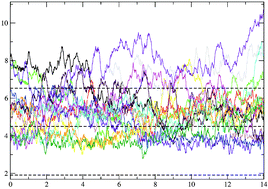An ab initio quantum mechanical/molecular mechanical (QM/MM) molecular dynamics (MD) simulation at double-ζ restricted Hartree–Fock (RHF) level was performed at 293.15 K, including first and second hydration shell in the QM region to study the structural and dynamical properties of the Be(II)-hydrate in aqueous solution. The first tetrahedrally arranged hydration shell, with the four water molecules located at a mean Be–O distance of 1.61 Å, is highly inert with respect to ligand exchange processes. The second shell, however, consisting in average of ∼9.2 water ligands at a mean Be–O distance of 3.7 Å and the third shell at a mean Be–O distance of 5.4 Å with ∼19 ligands rapidly exchange water molecules between them and with the bulk, respectively. Other structural parameters such as radial and angular distribution functions (RDF and ADF) and tilt- and theta-angle distributions were also evaluated. The dynamics of the hydrate were studied in terms of ligand mean residence times (MRTs) and librational and vibrational frequencies. The mean residence times for second shell and third shell ligands were determined as 4.8 and 3.2 ps, respectively. The Be–O stretching frequency of 658 cm−1, associated with a force constant of 147 N m−1 could be overestimated but it certainly reflects the exceptional stability of the ion–ligand bond in the first hydration shell.

You have access to this article
 Please wait while we load your content...
Something went wrong. Try again?
Please wait while we load your content...
Something went wrong. Try again?


 Please wait while we load your content...
Please wait while we load your content...